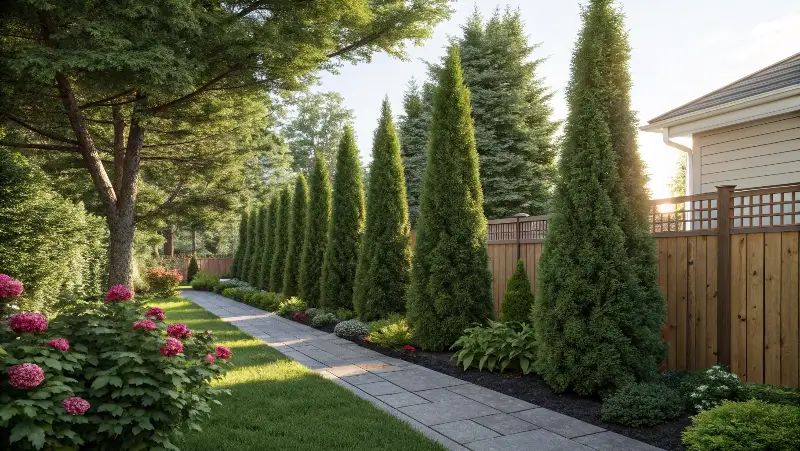
I’m well aware that many folks—especially in spring—start focusing on their yards and wonder how to keep curious neighbors from peeking over the fence. In this blog, I’ll share my personal take on growing the best privacy trees. I’ll talk about the most popular options, what they bring to your home, how to care for them, and some cool ideas you can try. Above all, I’ll keep this simple and fun. Let’s jump right in and see how these green guardians can give us that quiet, cozy, and private backyard we all daydream about.
Table of Contents
Introduction to Best Privacy Trees
The Increasing Demand for Natural Screens
Have you noticed how neighborhoods these days can feel a bit too open? Honestly, it’s like I can almost see my neighbor’s TV from my sofa! That’s why best privacy trees are so popular. I love how these trees form a living, breathing fence around my home.But why do so many homeowners like me choose this natural approach? Let me put it this way:
- They provide effective coverage without the stark look of a fence.
- They help reduce noise, giving you more peace.
- They deliver a beautiful backdrop to your yard year-round.
Plus, modern house designs often feature big windows and open layouts, which is great until you realize how exposed that makes you feel. Planting best privacy trees offers privacy without losing that fresh, airy vibe we enjoy indoors.
Why Best Privacy Trees Are Essential for Modern Homes
Let’s face it—today’s homes are practically designed to be on display. With massive windows and close proximity to neighbors, you can feel like you’re living under a microscope. That’s where best privacy trees shine:
- They create a protective wall of green.
- They let wildlife flourish.
- They add a natural look compared to fences or concrete walls.
I think it’s awesome that something so lovely can also act as your personal barrier. It’s a win-win, right?
Key Benefits of Planting Best Privacy Trees
Enhancing Property Value and Curb Appeal
Let’s talk money and looks. Most of us want our homes to appear appealing to passersby and potential buyers:
- Best privacy trees actually boost property value.
- They add an aura of care and attention.
- They create a strong first impression.
When I planted my first line of evergreens, I noticed how neat and professionally landscaped my yard looked. Moreover, from what I’ve heard, many real estate experts note that healthy, vibrant green barriers can fetch a higher price in the long run. If you ever decide to sell, future buyers will see mature trees as a huge plus.
Quick tips:
- Choose best trees for privacy known to adapt well in your region.
- Maintain them regularly for optimal curb appeal.
- Combine them with other shrubs or flowers for a layered effect.
Environmental Advantages and Ecosystem Support
I’m no hardcore scientist, but I do love seeing birds and squirrels frolicking among my trees. Planting best privacy trees offers:
- Shelter for local wildlife.
- Better air quality and less soil erosion.
- Reduction in wind, which can help lower heating costs in winter by acting as a natural barrier.
Plus, the U.S. Forest Service says that well-chosen trees improve local ecosystems and help maintain healthier neighborhoods. In fact, your big green screen might even provide shade that lowers cooling costs in summer. That’s like a gift that keeps on giving!I guess you can say that picking best trees for privacy isn’t just about shutting out the world. Instead, it’s about welcoming nature in a cautious, well-managed way. These trees do a lot more than block a neighbor’s questionable weekend barbecue. They truly bring life to your space.
Top 7 Best Privacy Trees for Your Yard
Choosing best privacy trees can feel overwhelming. So, here’s my personal top 7 list. Each offers unique advantages, from low maintenance to super-fast growth.
Arborvitae – An Evergreen Favorite
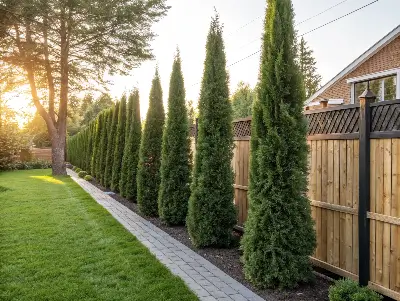
Arborvitae is often called the go-to species for privacy:
- Dense, uniform shape.
- Evergreen needles that stay lush year-round.
- Tolerant of cold climates.
Plant a row of them, and you’ll have an impressive wall of green almost immediately. I suggest spacing them out properly, though, so they don’t compete for nutrients.
Leyland Cypress – Fast-Growing Natural Shield
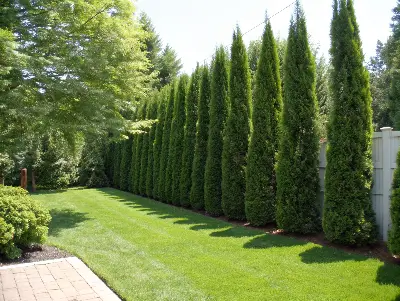
If I had to name a tree that shoots up before your very eyes, it’s Leyland Cypress:
- Rapid growth, sometimes over three feet per year.
- Creates a tall privacy screen.
- Thrives in many soil types.
On the flip side, its fast growth also demands consistent pruning. Still, it’s one of the best trees for privacy if you want that tall, majestic vibe quickly.
Emerald Green Arborvitae – Space-Saving, Dense Barrier
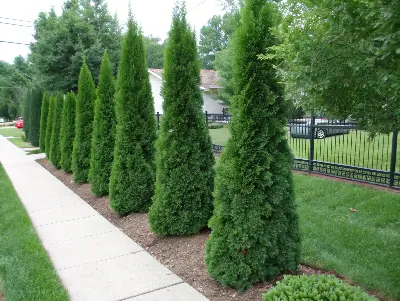
Got a small yard? Consider Emerald Green Arborvitae:
- Reaches about 10–15 feet, so it won’t overshadow everything.
- Grows slim and upright, good for tight spaces.
- Provides dense coverage with minimal horizontal spread.
They look elegant and require less pruning than some bigger giants. Honestly, they’re a neat solution for petite gardens.
Bamboo Varieties – Rapid-Growth Privacy Hedges
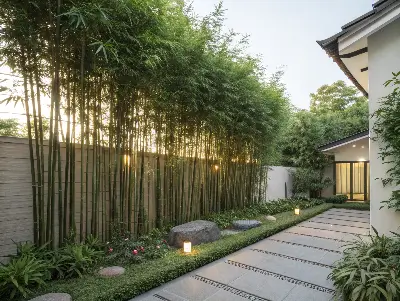
Although bamboo is technically a grass, many folks count it in their best privacy trees list:
- Extremely fast growth.
- Creates a unique, tropical look.
- Works wonders for tall hedges.
But watch out for running bamboo, which can invade the entire neighborhood. Clumping varieties are usually safer and less troublesome.
Holly Trees – Vibrant and Hardy Screening
Holly trees bring bright foliage and vivid berries:
- Year-round glossy leaves.
- Berries in winter that attract birds.
- Dense, prickly barrier.
If you’re searching for something visually appealing—and a bit deterrent to unwelcome visitors—holly might be perfect.
Thuja Green Giant – The Ultimate in Quick Coverage
Thuja Green Giant often appears on top lists of best privacy trees:
- Grows astonishingly fast.
- Reaches considerable height.
- Adapts well to various climates.
It’s also known to be fairly deer-resistant, which is great for rural or suburban areas with wildlife.
Skip Laurel – Dense Foliage for Maximum Seclusion
To block that prying neighbor’s view, Skip Laurel is a lifesaver:
- Thick, shiny leaves.
- Hardy across different soil types.
- Tolerates partial shade.
Skip Laurel might need pruning once a year, but the payoff is a tight, polished-looking hedge.
Factors to Consider Before Choosing Best Privacy Trees
Maintenance Needs vs. Growth Speed
Everything in life comes with trade-offs, and best privacy trees are no exception:
- Fast growers like Leyland Cypress or Thuja Green Giant = frequent pruning.
- Slower growers = you wait longer for a full screen.
I’ve learned the hard way that if you pick a super-fast cultivar, you can end up with weekend trimming marathons. On the other hand, slower ones may test your patience. It’s crucial to find the balance that fits your yard’s time and care budget.
Soil Quality, Climate, and Sunlight Requirements
Before you jump to plant anything, do a quick environment check:
- Look at your local climate zone for temperature extremes.
- Test soil acidity and drainage capacity.
- Determine how much direct sun your yard gets daily.
If your soil is clay-like and drains poorly, choose species that thrive in damp conditions (like certain hollies). Meanwhile, if you have scorching summers, go with something drought-tolerant. Best privacy trees often specify their ideal conditions on the plant tag or nursery label—just read up and ask your local nursery for extra tips.
Space Constraints and Long-Term Growth
We all start with tiny saplings, but they don’t stay small:
- Larger trees can overshadow homes and neighboring gardens.
- Roots can interfere with foundations or fences if planted too close.
- Some species, like Leyland Cypress, can tower over everything very quickly.
I’ve seen folks plant their trees just three feet from the house, only to regret it five years later. Give them the proper space to spread out. Think about how the yard will look when the tree hits maturity.
Tip for tight spaces:
- Consider narrower options like Emerald Green Arborvitae.
- Plant them in a strategic row with enough room for root growth.
- Prune lightly each year to maintain shape.
Planting and Care Tips for Best Privacy Trees
Proper Planting Techniques and Soil Preparation
So, you’ve picked your green buddies. Let’s make sure they have the best start:
- Dig a hole about twice the width of the root ball, but not too deep.
- Keep the root flare (where trunk meets roots) slightly above ground level.
- Backfill gently to remove air pockets and water thoroughly.
Additionally, spreading a bit of compost or well-aged manure can help feed them naturally. This kind of eco-friendly landscaping approach ensures your soil retains nutrients and fosters a healthy root system.
Watering, Pruning, and Fertilization Guidelines
For the first year or two, consistent watering is key. I usually water deeply once or twice a week, depending on rainfall:
- Keep the soil moist but don’t let it get waterlogged.
- Mulch around the base to retain moisture and moderate soil temperature.
- Avoid piling mulch against the trunk (it can invite pests).
Once your best privacy trees are established, they’ll need less fussing. Many can handle natural rainfall alone, though a deep soak during dry spells is usually appreciated.Fertilizing sparingly with a balanced, slow-release formula in spring can boost growth, but I caution against overfeeding—burning or damaging roots is no fun. Prune them:
- Once a year in late winter or early spring.
- To remove dead branches or shape the tree.
- Gently, leaving the subtle, natural form of each species.
Creative Landscaping Ideas with Privacy Hedges
Mixing Evergreens and Flowering Shrubs
Blending different plants can really make a statement:
- Pair best privacy trees like Arborvitae or Green Giant Thuja with blooming shrubs such as hydrangeas.
- Layer smaller plants in front for color diversity (think azaleas or rhododendrons).
- Insert ornamental grasses here and there for texture.
I love how a layered look keeps the eye moving. Plus, it helps guard against pests that might target a single species.Short on inspiration? Just check out “hedgerow ideas” or pictures on gardening sites. Sometimes, the random mix can be surprisingly beautiful.
Incorporating Hardscape Elements and Garden Features
Trees and hedges alone can be awesome, but adding a couple of subtle touches brings your yard to life:
- A stone or gravel path weaving between your best privacy trees.
- A small seating area hidden behind evergreens.
- A birdbath or water feature for a calming vibe.
When I first set up my privacy hedge, I placed an adorable wooden bench behind it. Now it feels like a secret garden. And if you’d like a moderate grower for some ornamental flair, check out the Japanese Blueberry Tree. It fits into many designs without overwhelming nearby plants.
Frequently Asked Questions
What is the quickest growing privacy tree?
I’d probably name Leyland Cypress or Thuja Green Giant. In fact, both can skyrocket in height, sometimes more than three feet a year. Watch out, though—fast growth means you’ll be trimming them more often.
What is the best tree for blocking view?
Arborvitae cultivars (like Emerald Green) or holly trees usually do great at blocking out those prying eyes. Both have dense foliage that remains year-round. Plus, their evergreen nature means consistent coverage no matter the season.
What is the best plant to block neighbors’ views?
Hands down, bamboo can give you the quickest tall barrier. Just be cautious and choose clumping bamboo to avoid invasive root problems. This type helps form super-thick, hedge-like screens without conquering your entire lot (and your neighbor’s).
What is the best low maintenance privacy hedge?
Emerald Green Arborvitae is my personal pick. It grows at a moderate rate, so you can skip constant pruning. Likewise, Skip Laurel is another popular choice for folks who want fuss-free seclusion. Both hold their shape well, adapt to various soils, and tend to resist pests better than some other species.
Final Thoughts
To sum up, best privacy trees give you real solutions for the question of how to keep your backyard peaceful. You won’t be stuck staring at a boring fence because these living walls bring color, texture, and even wildlife to your world.
Yet, remember that no two yards are exactly alike. If you’re dealing with a cramped suburban lot, perhaps a slender arborvitae row works. Meanwhile, if you want to hush traffic noise on a larger country property, try Thuja Green Giant or Leyland Cypress.
Ultimately, the best privacy trees do more than block out your neighbor’s yard parties. They anchor your outdoor space, greet you with fresh greenery, and can even save you a bit on energy bills in the long run. Personally, I love that I can hide from street noise while still feeling connected to nature.
Whether it’s bamboo or an evergreen hedge, a bit of research and some basic care go a long way. So, as you plan your yard makeover this season, consider a living fence that grows with your home and enriches your life. That, to me, is the magic of best privacy trees. Enjoy your green getaway!
